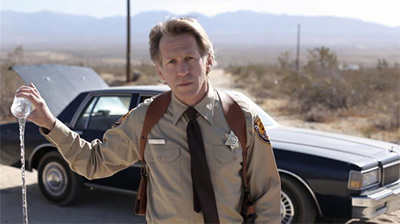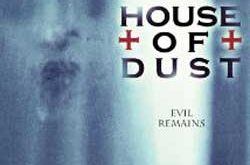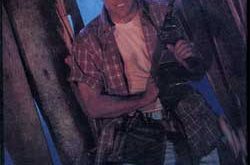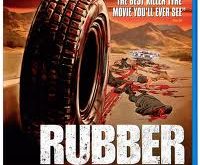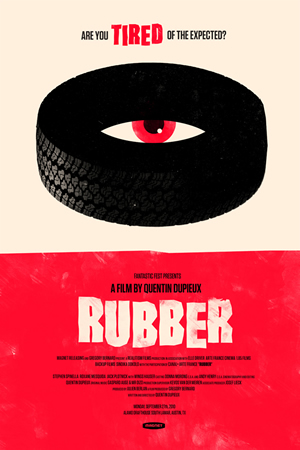
SYNOPSIS:
Rising from a sandy grave, lost in the desert, an inanimate tire comes to life and learns to roll on his own. Making his way toward a nearby, sparsely populated town, the tire gains telepathic powers enabling him to blow up anything, or anyone, that stands in his path. Soon he falls for a mysterious brunette in a passing car and must face the town’s sheriff. Alone and desperate, he searches for companionship and the means to quench his lust for destruction.
REVIEW:
Of all the films shown at the 13th Annual Nevermore Film Festival in Durham, NC in February, Rubber is the most irreverent and controversial. Horror movies in the past have never shied away from bringing inanimate objects to life, setting them on a murder spree: cars (Duel, The Car, Christine), toys (Trilogy of Terror, Child’s Play) or even tomatoes (Attack of the Killer Tomatoes). But in Rubber, writer-director Quentin Dupieux takes it to the extreme and animates a common car tire: a brilliant concept that occasionally shuffles about too long but still promises ample amounts of pathos and humor. He also provides the tire with a surprising amount of personality as it rolls across the desert scenery. The tire, given the name Robert in the credits, slowly learns how to roll without falling over: he gains a passion in destroying things, falls for a sexy young lady, takes revenge on a trucker the drives him off the road and even tries to learn to swim.
Rubber benefits from having an outrageously original opening that immediately sets the tone for the movie and shatters the fourth wall. When Lieutenant Chad steps out of his patrol car to address a gathering of movies goers and proceeds to give an inspired monologue about the events in movies happening for “no reason,” the result is at once baffling and hilarious setting up for the introduction of the Robert the tire and his antagonistic adventures. Suddenly, the idea of a tire “waking up” and strolling merrily down the road on its own is perfectly reasonable and the audience is primed to witness whatever the writer-director dreams up. Dupieux masterfully weaves together the narrative, the forces driving the narrative, the onscreen audience thrust into the narrative and the audience watching Rubber safely in their theater seats. When it works, Rubber is a real treat to witness…and be a part of. It’s funny, amazing, crazy, simple and complex all at once.
Somehow, however, Dupieux also manages to become trapped in the world he is trying to deconstruct and ends up bound back behind the fourth wall he works so hard to knock down in the opening sequence. Strangely, after succeeding in establishing that anything can happen for “no reason,” he rarely builds on that concept other than to allow Robert to come to life and gain special powers. The door that allows “anything can happen” is open and nothing else manages to creep through. There are a number of interesting, captivating nuggets of whimsy and genius that make to the screen but nothing really captures the pure imagination that launches the film. This makes the second act a bit longer and repetitive than expected. After the first 3 or 4 exploding animals or heads, the sense of wonder has faded and the lack of a real story begin to be exposed. Occasionally, another flash of zany wit will zip across the screen – usually featuring Wings Hauser – and the film restores what made it so fascinating early on, especially the event (not to spoil) that transitions the film to its final act where Robert, done with the small town life, casts aside his obsessions, finds others like him and heads west to discover larger dreams. With that, the film ends on a high note.
Largely consisting of unknown, but at imes recognizable, character actors, Rubber contains some equally inspired performances. Stephen Spinella, as Lieutenant Chad, leads the cast and provides the all-important speech with passion and conviction. His role, his presence, is the heartbeat of the story; he may not always be on screen, but his character’s impact is always felt. Equally important and equally impressive is Jack Plotnick as the accountant. His character, sometimes more so than Lieutenant Chad, is the strand of reason that binds the imaginary fourth wall back to the onscreen world. Roxanne Mesquida plays Sheila, the mysterious brunette to whom Robert is drawn so passionately. While, at first, she’s mostly there to “be pretty” and to attract the rubber rim of death, she is alter given a scene where she provides the voice to a dummy set to lure Robert out into the open; here she displays a delightful sense of comedic timing helped immensely by sounding off co-star Stephen Spinella. Then there’s Wing Hauser, who manages to upstage all the rest (except maybe Robert) and steal the show. He’s wonderfully funny, in control and four steps ahead of everyone: at least until he mistakenly comes face to face with Robert. The success of the film hinges on how successfully these actors brings the concepts and nonsensical dialog to the screen and everyone delivers. Bravo.
Rubber examines the mechanics of movie making, movie watching and the reasoning behind each. Not really a horror film at all, it is a parody of not only horror films but all films choosing a killer animated tire as its draw. Laugh out loud funny at times, the movie takes unexpected turns shocking, surprising and delighting the audience. Great performances keep the pace from coming to a stand still during the second act. The film never really manages to top the brilliance of its opening act, but still holds together long enough for a satisfying conclusion. It’s a great time at the movies, poking fun at movies and examining movies all at once. Silly, stupid, funny and inspired – just go see it.
8 out of 10
 Horror News | HNN Official Site | Horror Movies,Trailers, Reviews
Horror News | HNN Official Site | Horror Movies,Trailers, Reviews

